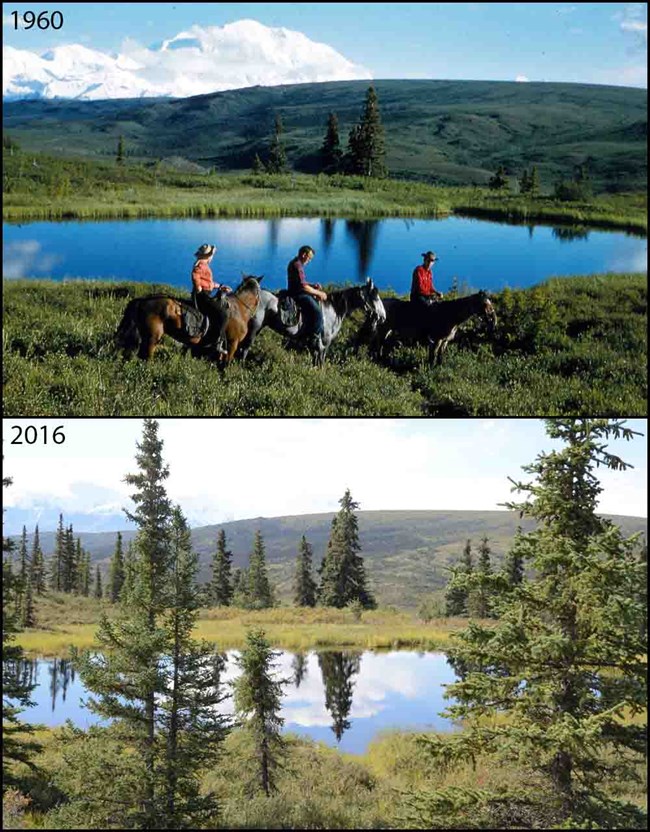Last updated: December 30, 2019
Article
Vegetation Change over the Past Century

Ruth A.M. Schmidt (Archives & Special Coll., Consortium Library, University of Alaska Anchorage) (1960), Jedediah Brodie (2016)
A new paper in the Ecological Society of America journal Ecology discusses the issue of vegetation change over the past century or so in Denali National Park and Preserve. Using analyses of matched historical/recent photo pairs that were brought into a GIS, this study quantifies probabilities of transitions among broad vegetation types over a long time period in relation to important landscape gradients such as elevation, potential solar radiation, and permafrost. Among other results, we found that riparian areas in the park were clearly non-equilibrial, with many open gravel river bars transitioning to thick shrubs in recent decades, but only 0.1% of shrub-dominated areas on alluvium converting "back" to gravel. Interestingly, overall rates of change detected using this approach (which has its limitations, too) are modest, perhaps less than are being observed elsewhere in our rapidly warming state. This work adds a new perspective to the growing body of information concerning spatial and temporal dynamics of vegetation in the park, in a region of the world experiencing dramatic, unprecedented warming temperatures.
Variability in the expansion of trees and shrubs in boreal Alaska
Abstract
The expansion of shrubs and trees across high‐latitude ecosystems is one of the most dramatic ecological manifestations of climate change. Most of the work quantifying these changes has been done in small areas and over relatively recent time scales. These land‐cover transitions are highly spatially variable, and we have limited understanding of the factors underlying this variation. We use repeat photography to generate a data set of land‐cover changes in Denali National Park and Preserve, Alaska, stretching back a century and spanning a range of edaphic, topographic, and climatic conditions. Most land‐cover classes were quite stable, with low probabilities of transitioning to other land‐cover types. The advance of woody vegetation into low‐stature tundra, and the spread of conifer trees into shrub‐dominated areas, were both more likely at low elevations and in areas without permafrost. Permafrost also reduced the likelihood of herbaceous vegetation transitioning to woody cover. Exceptions to the general trend of relative stability included nearly all (96%) of the broadleaf forest–dominated areas being invaded by conifers, an expected successional trajectory, and many open gravel river bars (17.8%) transitioning to thick shrubs. These floodplain areas were distinctly not at equilibrium, as only 0.1% of shrub‐dominated areas converted to gravel. Warming temperatures in coming decades and concomitant declines in the extent of permafrost are predicted to enhance the spread of woody vegetation in Denali further, but only by ~3%. Land‐cover transitions, notably the rapid advance of trees and shrubs observed in other studies, could be less likely and more spatially heterogeneous here than in other high‐latitude systems.
Brodie, J. F., C. A. Roland, S. E. Stehn, and E. Smirnova. 2019. Variability in the expansion of trees and shrubs in boreal Alaska. Ecology 00(00):e02660. 10.1002/ecy.2660
